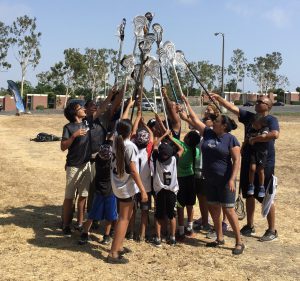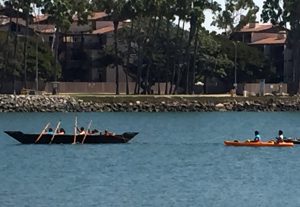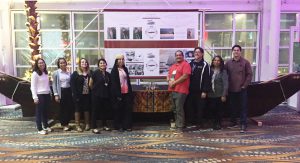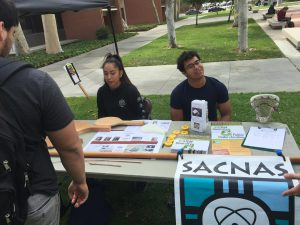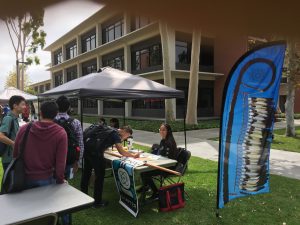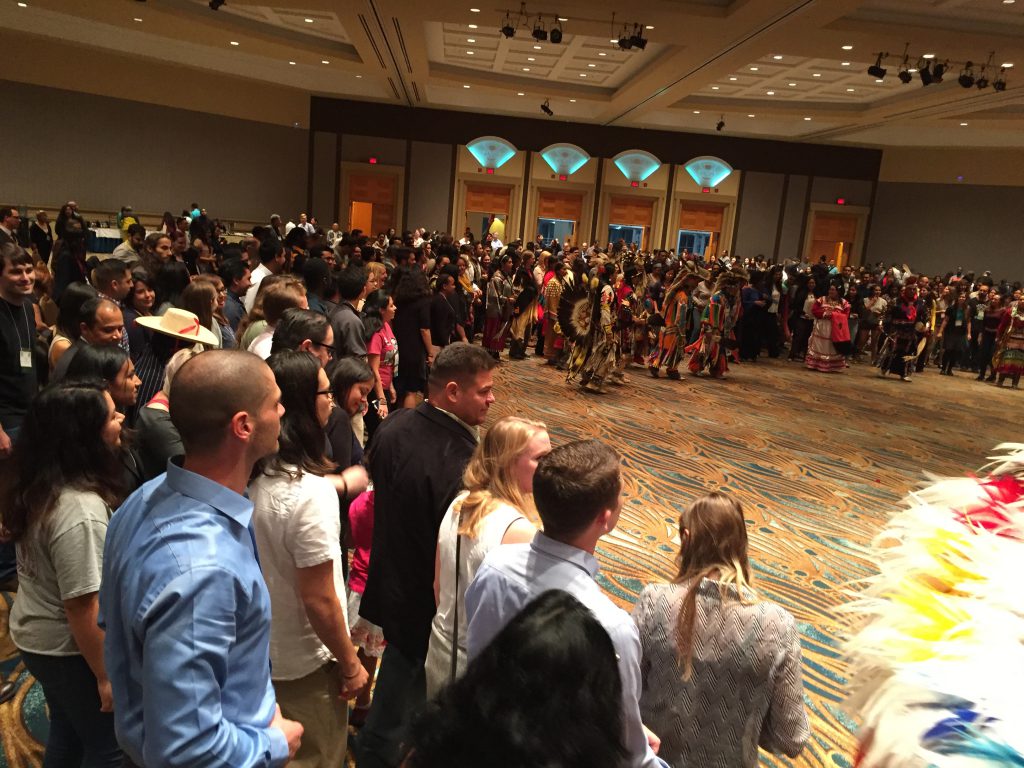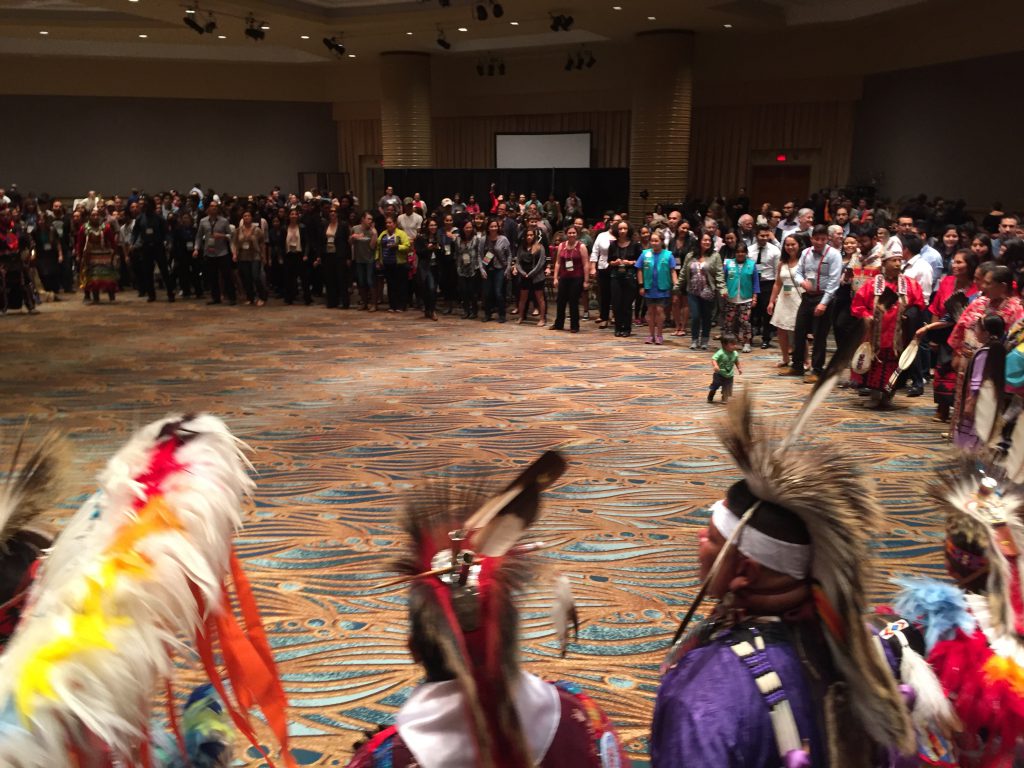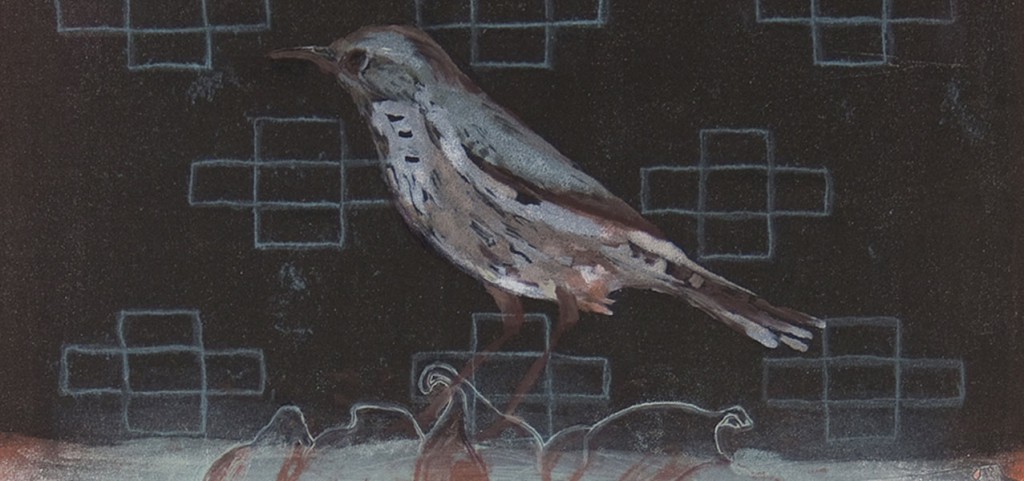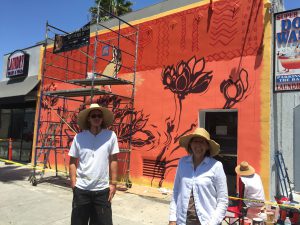California Indian Genocide Awareness
As part of an ongoing effort to increase awareness of the Californian Indian Genocide, the American Indian Studies Program and the American Indian Student Council sponsored several events this Fall of 2016.
The American Indian Student Council installed two public artworks to raise awareness of the California Indian Genocide on campus that was on view for the entire month of November. Link to article These artworks installed by American Indian Student Council officers, Ashley Glenesk and Miztla Aguilera with Professor Craig Stone were seen by thousands of students, faculty and staff were also featured on the CSULB webpage. Link to article
As part of Native American Month, the Native American Student Council sponsored a lecture by Benjamin Madley the author of An American Genocide: The California Indian Catastrophe 1846-1873, in conjunction with the Ethnic Studies 319 and AIS 336 courses. The presentation took place in the USU Ballrooms on Tuesday, November 8th from 2:00 to 3:15 pm, followed by a book signing. Over one-hundred and fifty students attended the lecture in conjunction with the Puvu Indigenous Cultural Sustainability Lecture Series and the Scholarly Intersections Grants from the College of Liberal Arts.
It’s time to acknowledge the genocide of California’s Indians
By Benjamin Madley
Between 1846 and 1870, California’s Indian population plunged from perhaps 150,000 to 30,000. Diseases, dislocation and starvation caused many of these deaths, but the near-annihilation of the California Indians was not the unavoidable result of two civilizations coming into contact for the first time. It was genocide, sanctioned and facilitated by California officials.
Neither the U.S. government nor the state of California has acknowledged that the California Indian catastrophe fits the two-part legal definition of genocide set forth by the United Nations Genocide Convention in 1948. According to the convention, perpetrators must first demonstrate their “intent to destroy, in whole or in part, a national, ethnic, racial or religious group, as such.” Second, they must commit one of the five genocidal acts listed in the convention: “Killing members of the group; causing serious bodily or mental harm to members of the group; deliberately inflicting on the group conditions of life calculated to bring about its physical destruction in whole or in part; imposing measures intended to prevent births within the group; forcibly transferring children of the group to another group.”
It is not an exaggeration to say that California legislators also established a state-sponsored killing machine.
California’s Legislature first convened in 1850, and one of its initial orders of business was banning all Indians from voting, barring those with “one-half of Indian blood” or more from giving evidence for or against whites in criminal cases, and denying Indians the right to serve as jurors. California legislators later banned Indians from serving as attorneys. In combination, these laws largely shut Indians out of participation in and protection by the state legal system. This amounted to a virtual grant of impunity to those who attacked them.
That same year, state legislators endorsed unfree Indian labor by legalizing white custody of Indian minors and Indian prisoner leasing. In 1860, they extended the 1850 act to legalize “indenture” of “any Indian.” These laws triggered a boom in violent kidnappings while separating men and women during peak reproductive years, both of which accelerated the decline of the California Indian population. Some Indians were treated as disposable laborers. One lawyer recalled: “Los Angeles had its slave mart [and] thousands of honest, useful people were absolutely destroyed in this way.” Between 1850 and 1870, L.A.’s Indian population fell from 3,693 to 219.
It is not an exaggeration to say that California legislators also established a state-sponsored killing machine. California governors called out or authorized no fewer than 24 state militia expeditions between 1850 and 1861, which killed at least 1,340 California Indians. State legislators also passed three bills in the 1850s that raised up to $1.51 million to fund these operations — a great deal of money at the time — for past and future anti-Indian militia operations. By demonstrating that the state would not punish Indian killers, but instead reward them, militia expeditions helped inspire vigilantes to kill at least 6,460 California Indians between 1846 and 1873.
The U.S. Army and their auxiliaries also killed at least 1,680 California Indians between 1846 and 1873. Meanwhile, in 1852, state politicians and U.S. senators stopped the establishment of permanent federal reservations in California, thus denying California Indians land while exposing them to danger.
State endorsement of genocide was only thinly veiled. In 1851, California Gov. Peter Burnett declared that “a war of extermination will continue to be waged … until the Indian race becomes extinct.” In 1852, U.S. Sen. John Weller — who became California’s governor in 1858 — went further. He told his colleagues in the Senate that California Indians “will be exterminated before the onward march of the white man,” arguing that “the interest of the white man demands their extinction.”
Beyond premeditated, systematic killings of California Indians, other acts of genocide proliferated too. Many rapes and beatings occurred, and these meet the U.N. Genocide Convention’s definition of “causing serious bodily harm” to victims on the basis of their group identity and with the intent to destroy the group. The sustained military and civilian policy of demolishing California Indian villages and their food stores while driving Indians into inhospitable mountain regions amounted to “deliberately inflicting on the group conditions of life calculated to bring about its physical destruction in whole or in part.” Because malnutrition and exposure predictably lowered the birthrate, some state and federal decision-makers also appear guilty of “imposing measures intended to prevent births within the group.”
Finally, the state of California, slave raiders and federal officials were all involved in “forcibly transferring children of the group to another group.” Thousands of California Indian children suffered such forced transfers. By breaking up families and communities, forced removals constituted “imposing measures intended to prevent births within the group.” In effect, the state legalized abduction and enslavement of Indian minors; slavers exploited indenture laws and federal officials prevented U.S. Army intervention to protect the victims.
The issue of genocide in California poses explosive political, economic and educational questions for the state, California’s tribes and individual California Indians. It is up to them — not academics like me — to determine the best way forward.
Will state officials tender public apologies, as Presidents Ronald Reagan and George H.W. Bush did in the 1980s for the relocation and internment of some 120,000 Japanese Americans during World War II? Should state officials offer compensation, along the lines of the more than $1.6 billion Congress paid to 82,210 of these Japanese Americans and their heirs? Might California officials decrease or altogether eliminate their cut of California Indians’ annual gaming revenues ($7.3 billion in 2014) as a way of paying reparations? Should the state return control to California Indian communities of state lands where genocidal events took place? Should the state stop commemorating the supporters and perpetrators of this genocide, including Burnett, Kit Carson and John C. Frémont? Will the genocide against California Indians join the Armenian genocide and the Holocaust in public school curricula and public discourse?
These are crucial questions. What’s beyond doubt is that the state and the federal government should acknowledge the genocide that took place in California.
Decency demands that even long after the deaths of the victims, we preserve the truth of what befell them, so that their memory can be honored and the repetition of similar crimes deterred. Justice demands that even long after the perpetrators have vanished, we document the crimes that they and their advocates have too often concealed or denied. Finally, historical veracity demands that we acknowledge this state-sponsored catastrophe in all its varied aspects and causes, in order to better understand formative events in both California Indian and California state history.
Benjamin Madley is assistant professor of history at UCLA and the author of “An American Genocide: The United States and the California Indian Catastrophe, 1846-1873.”
Link to Past Genocide Awareness Efforts
Ancestors Final Journey Home
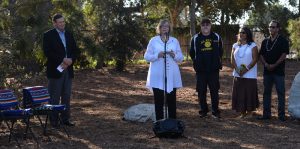
In advance of California Native American Day, California State University Long Beach held an event to officially recognize the reburial of remains and various artifacts in an area on the campus. CSULB President Jane Close Conoley expressed her honor that the school is one of the first institutions to complete a reburial on a university campus under the Native American Graves Protection and Repatriation Act (NAGPRA). The celebration included speeches and traditional Native American songs. Long Beach September 22, 2016. Photo by Brittany Murray, Press Telegram/SCNG
CSULB becomes the first university to support a reburial of Native American ancestral remains on a campus.
“As an alumnus of California State University Long Beach and first student to graduate with an American Indian Studies degree from CSULB, I am proud of my school for listening to our Indian Nation representatives and Indian Studies faculty and students for giving appropriate rest and protection to these ancestors so that they may fulfill their journey. This has been the only time that a University has given of its campus for repatriation and establishes a strong precedent for other institutions who have made their footprint on top of, and obtained research dollars from, Native American graves. I know that this repatriation has gone a long way to repair relations and create a strong bond between Indian Nations in Southern California and the University,” said Shannon Keller O’Loughlin (Choctaw), Alumnus and former member of the Native American Graves Protection and Repatriation Act Review Committee, lawyer, and Chief of Staff of the National Indian Gaming Commission. (Ms. O’Loughlin’s views and opinions are her own and do not necessarily reflect the views of the National Indian Gaming Commission.)
Link to Press Telegram Article
Ancestors Final Journey Home
In 1953, Long Beach State Anthropology Professor, Dr. Ethel Ewing, was called to investigate a report of human remains and artifacts unearthed during the construction of the Los Altos Shopping Center. What was encountered was a cemetery linked to the ancient village site of Puvungna, the spiritual center of the Gabrieleno-Tongva tribe. What was once the expansive traditional land-base of the tribe, became economic fodder for land developer, L. S. Whaley, and his Los Altos Realty, Inc. in a post WWII urban setting. This scenario has repeated itself throughout the decades, as Southern California Indian cemeteries and sacred sites have been disturbed and destroyed as a result of uncontrolled development.
Universities, and other public institutions, have become repositories of Native American ancestral remains that were abandoned by a system that participated in salvage excavations and failed attempts to maintain the dignity of human remains while being used for research. After generations of ancestors physically confined within institutions, the Native American Graves Protection and Repatriation Act of 1990 [1]implemented a change that would return the dignity and integrity to these individuals/ancestors.
In 1994, the ancestors of the Village of Puvungna were repatriated under the Native American Graves and Protection Act of 1990. Since then, there has been a concerted effort by culturally affiliated tribes, including the Gabrieleno/Tongva and Juaneno/Acjachemen, to rebury their ancestors on campus, the closest location to their original resting place.
It has been a long drawn out process, often a conflicting and unfriendly setting, through multiple CSULB presidents, finally finding resolution with the support of CSU Chancellor Tim White, interim President Don Para, Provost David Dowell, and with the support of CSULB President Jane Conoley, and her current administration who have embraced the reburial.
On July 23, 2016, the reburial ceremony was quietly held on campus, members of ten local tribes, including the Gabrieleno/Tongva, the Juaneno/ Acjachemen, and members of the Chumash tribe took an active part in the reburial ceremony. The ceremony took place on campus at a site collectively chosen by a collaboration between university and tribal representatives. After osteological investigation, the final count of individuals whose remains have been reburied increased from the original 21 to representing about 100 ancestors.
CSULB takes position as the first academic institution to complete a Native American reburial under NAGPRA on their campus. However, this reburial was not the first on campus. Prior to NAGPRA, in 1990, an ancestor was reburied on campus after it was unearthed during the installation of a sprinkler system. AIS Program Director, Craig Stone was a student at CSULB at that time and attended the meeting with then CSULB President Steven Horn in 1978 which resulted in the first reburial of an ancestor at CSULB in 1979.
The recent major reburial process was incorporated into the educational setting across campus linking eleven courses in an unprecedented three-year collaboration. The courses included are from American Indian Studies, Anthropology, Art, Design, Environmental Science and Policy and Recreation and Leisure Studies at CSULB with the consistent support of Vice President, David Salazar. The excavation was overseen by Dr. Sachiko Sakai, Cogstone Resource Management, Cindi Alvitre and supported by the CSULB Physical Planning/Facilities Management and their Staff.
A major role for many aspects of the reburial was performed by current NAGPRA Coordinator, Cindi Alvitre, who coordinated and oversaw the preparation of the ancestors for reburial by students, tribal community members, and scientists to correct a historical wrong.
Louis Robles, Jr., the Chairman of the Committee on Native American Burial Remains and Cultural Repatriation at CSULB is the son of the late Lillian Robles who along with Xoxa Hunut, Jimmy Alvitre, Jimmy Castillo, Anthony Morales, Rebcecca Robles, Cindi Alvitre, Rhonda Robles, Dwight Manuel, Georgiana Sanchez, Jan Sampson, Eugene Ryule, Jerry De La Moira, Craig Stone, Deborah Sanchez, Gloria Arellanes and many others, were actively involved in this on-going effort to rebury the ancestors.
It is with great pride that we announce the completion of this effort to rebury the ancestors at CSULB on the eve of the 2016 celebration of California Native American Day.
[1] https://www.nps.gov/nagpra/ The Native American Graves Protection and Repatriation Act (NAGPRA) was enacted on November 16, 1990, to address the rights of lineal descendants, Indian tribes, and Native Hawaiian organizations to Native American culture. The Native American Graves Protection and Repatriation Act (NAGPRA) was enacted on November 16, 1990, to address the rights of lineal descendants, Indian tribes, and Native Hawaiian organizations to Native American cultural items, including human remains, funerary objects, sacred objects, and objects of cultural patrimony. The Act assigned implementation responsibilities to the Secretary of the Interior.
Fall 2016 Lectures and Events
Fall 2016 Lectures and Events
Date: Tuesday, November 1
Time: 12:00 pm – 1:30 pm
Location: USU Southwest Terrace
Title: American Indian Heritage Month Celebration Kick Off
Description: The American Indian community of Long Beach and Los Angeles will showcase the songs and dances of various Native cultures.
Date: Wednesday, November 2
Time: 2:00 pm – 3:15 pm
Location: Puvungna (adjacent to Parking Lot 20)
Title: Cultural Significance of Puvungna (CSULB)
Description: Cindi Alvitre (Tongva/Gabrielino), American Indian Studies Program Lecturer and CSULB NAGPRA Coordinator will provide an enriching narrative on the Indigenous peoples of the region by articulating the cultural significance of Puvungna (CSULB) and discuss the lack of culturally, environmental sustainable spaces. *Offered in collaboration with the Puvu Indigenous Cultural Sustainability Series
Date: Monday, November 7
Time: 2:00 pm – 3:15 pm
Location: Multicultural Center
Title: Flora and Fauna Biodiversity of the Tongva/Gabrielino People
Description: Craig Torres (Tongva/Gabrielino), Ti’at Society member and cultural revitalist, will discuss the original topographical and maritime flora and fauna biodiversity of the Tongva/Gabrielino peoples. *Offered in collaboration with the Puvu Indigenous Cultural Sustainability Series
Date: Tuesday, November 8
Time: 2:00 pm – 3:15 pm
Location: USU Ballrooms
Title: An American Genocide: The California Indian Catastrophe
Description: Professor Benjamin Madley, UCLA American Indian Studies and History Departments will lecture about the Genocide of California Indian people based on his recently published book titled “An American Genocide: The California Indian Catastrophe.” *Offered in collaboration with the Puvu Indigenous Cultural Sustainability Series
Date: Wednesday, November 9
Time: 1:00 pm – 5:00 pm
Location: Puvungna (adjacent to Parking Lot 20)
Title: Seri Comca’ac Women’s Artisans Cooperative
Description: The Seri Comca’ac Women’s Artisans Cooperative (from Mexico) will provide cultural exchange and expressions. Discussion regarding the reflective problematics of cultural sustainability within a transnational context will occur. *Offered in collaboration with the Puvu Indigenous Cultural Sustainability Series
Date: Wednesday, November 16
Time: 2:00 pm – 3:15 pm
Location: Anatol Center (AS-119)
Title: Indigenous Plants and Cultural Sustainability.
Abe Sanchez (Perepucha), community leader and cultural revitalist, will demonstrate the utilization of traditional plants from the region for cultural and sustainable purposes. *Offered in collaboration with the Puvu Indigenous Cultural Sustainability Series
Dates: Saturdays Oct 22, Nov 5, Nov 19, Dec 3, Dec 17
Time: 12:00 – 6:00 pm
Title: Creators Game,” Lacrosse at Puvungna
Description: Indigenous youth and community are invited to come learn more about the Game That Pleases the Creator. Whether you have played the Creator’s game, also known as lacrosse, Stickball or have never seen the Creator’s Game before, there is a place for you to play and learn about this good medicine that is more than a game. We will be learning more about the indigenous origins of the game through storytelling, learn fundamentals of the game for playing, and then hold a Medicine Game each day. Each day will be started and finished with traditional drumming and singing. Special Thanks to Cindi Alvitre and the Tongva People for permission to use the sacred site of Puvungna.
LOCATION: Sacred Site of Puvungna,* campus of CSU Long Beach, located next to Lot #20. CSULB, 1250 Bellflower Blvd., Long Beach CA 90840
PARKING: Daily parking permits can be purchased $5 per day, from yellow vending machines located in lots throughout campus. These lots are 1, 11, 12, 13, 14, 16, and parking structure.
CONTACT/RSVP: Thomas Reed (Oneida), (714) 343-2698, Thomas.reed714@gmail.com Indigenous Youth RSVP ahead of time for potential stick and gear giveaways.
*Puvungna is located off of Earl Warren Drive, General Parking Lot #20, across from the dorms, and just south of the Japanese Gardens. This is a non-sponsored campus event. Campus is handicapped accessible. Bring your folding chairs. Not responsible for theft, loss, accident, injury or personal expenses. Absolutely no alcohol or drugs allowed.
CSULB Campus Maps, http://daf.csulb.edu/maps/
Ti’at Restoration Completed!
Restoration of Tiat Completed
On September 11, 2016 the Tiat restoration was celebrated with the launching of the Moommat Ahiko in Long Beach. The Tiat was restored after a restoration process that began in 2013. The American Indian Studies Program is honored to have been part of this collaborative effort with Tiat Society, the CSULB Student Chapter of the American Indian Science and Engeneering Society and the Department of Engeneering.
The Students who have been active in the Tiat Restoration and the Reburial presented at the 2016 SACNUS Conference at the Long Beach Convention Center on October 12 Link to SACNAS Conference Link to Dr. Keolu Fox on Kuelana and Science Link to Dr. Gregory Cajete Presentation
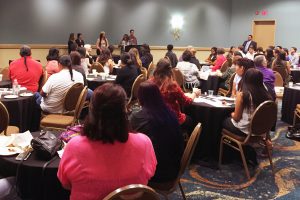
AIS Faculty and Students welcome Native American attending the SACNAS Conference at the Native American Mixer.
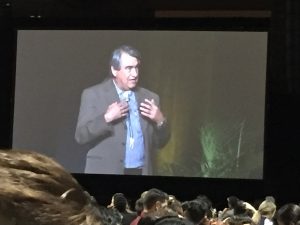
Thousands of Latino and American Indians attend Keynote by Gregory Cajete, PhD, University of New Mexico (Santa Clara Pueblo) at the SACNAS Conference in Long Beach. Link to Cajete Presentation
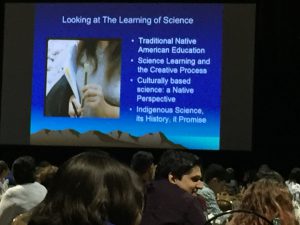
Slide from Dr. Cajete lecture on how to integrate indigenous ways of knowing into science education.

Display of Tiat Restoration in Fine Arts Building 4
All CSULB students were encouraged to participate in this AISES sponsored project. Funded by the College of Engeneering. The College has a sustained commitment to supporting American Indian Students at CSULB and in 2012, the CSULB College of Engeneering was recognized as being #1 in the nation for granting Bachelor’s degrees in Engeneering to American Indians.
More information about the Tiat Restoration is listed below:
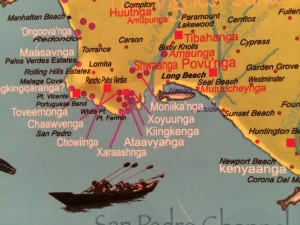
 Tiat Restoration Mixer 4:15 September 12, 2014
Tiat Restoration Mixer 4:15 September 12, 2014
Restoration Project
Under the direction of Marcus Lopez and Mike Anderson the Ti’at was moved to CSULB on Saturday, July 27. CSULB Students will be able to participate in repairing the Ti’at and learning more about the meaning and significance of this ocean going canoe during the Fall semester of 2014. In the Spring of 2014, Marcus Lopez (Chumash) kicked off the first event for the Tiat Restoration on Friday, April 25 at CSULB. Free lunch was provided to the participants which took place in the Engineering Department where the Ti’at will be repaired. (See: Ti’at Fliers) The Ti’at Restoration Project was featured in an Orange County Register Article. Link to Orange County Register Article.
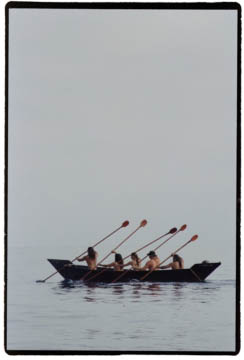
Image of Ti’At by Magallanes and Edwards About the Photographers
Student Chapter Tiat Restoration Project featured in Spring 2013 issue of Winds of Change Magazine
The CSULB American Indian Science and Engineering Student Chapter will be repairing the Moomat Ahiko at CSULB this year. The Moomat Ahiko is a plank canoe that for the past 20 years has provided the Tongva and neighboring First Nations the pride and unity around the Indigenous Maritime culture . Since its conception, the Ti’At has succeeded in a variety of cultural voyages and village hops. Since the participation in the Ti’At Festivals in the island of Pimu (Catalina island), and participation at the Aquarium of the Pacific, International Music Festival, etc., the Moommat Ahiko has proven to be a sea worthy and cultural iconic vessel. Yet along with the uniqueness, the cultural renaissance of the Tongva Nation has been an illumination of the success of the Ti’At and Tongva peoples. And because of this success and past activity, the wear and tear of the Plank Canoe, it is time for repair and continuing of building a crew for future voyages.
About the Art 440/540 Course and the Faculty who are co-teaching this course.
Link to Article about Cindi Alvitre and The Ti’at Link to Article about Public Art from Last Year’s Class Link to Video of Public Art Project from Last Year’s Class Link to information about Cynthia Herrera Link to Craig Stone’s Public Art Project: Image Emergence, The Promenade of Clouds
We Are Changing — New Partnerships in AIS
We Are Changing — New Partnerships in AIS
Link to Daily 49er article about new Minor

The American Indian Studies Program has recently established partnerships in three colleges to offer a revised minor in Native American Cultures for students in majors leading to professions that impact the lives of American Indian People.
These partnerships began in the Fall of 2014 with a focus on Museum Studies/CRM, Anthropology, Social Work, Art History and Film as the first phase of changes to American Indian Studies and now include partnerships with nineteen departments and programs. In the Fall of 2016 we will expand our partnerships with the School of Art and with the Department of History with cross-listed courses in American Indian History and Contemporary Indigenous Arts in the United States and American Territories.
In the Spring of 2016 students in American Studies, Anthropology, Art, Art History, Comparative World Literature, English, Film & Electronic Arts, Geography, History, Human Development, Journalism, Kinesiology, Museum Studies, Music, Philosophy, Political Science, Recreation & Leisure Studies, Social Work, and Women’s, Gender & Sexuality Studies will be able to enhance their studies with the new AIS Minor and and graduate on time.
Students interested in learning more about the AIS Minor in Native American Cultures Link to New 15 Unit Minor or our new Certificate in American Indian and Indigenous Studies Link to 21 Unit Certificate are encouraged to contact the Director of the AIS Program, Craig Stone at: cstone@csulb.edu
Current AIS Minors should contact AIS Advising in PH 1, Room 104 to see if the new 15 unit Minor will help them to graduate in less time. 562.985.7804
American Indian Graduation Celebration
 American Indian Graduates gathered with their families to feast and celebrate their achievements on Saturday, May 14th from 6-9 p.m. in the University Student Union Ballrooms. American Indian Graduates were honored with song, prayer, gifts and awards in the USU Ballrooms with over one hundred and thirty in attendance. Student, Alumni, Memorial, Prayer, Round Dance, Tongva and Kumeyaay songs were sung during the evening to celebrate these achievements and to honor and remember those who have gone before us.
American Indian Graduates gathered with their families to feast and celebrate their achievements on Saturday, May 14th from 6-9 p.m. in the University Student Union Ballrooms. American Indian Graduates were honored with song, prayer, gifts and awards in the USU Ballrooms with over one hundred and thirty in attendance. Student, Alumni, Memorial, Prayer, Round Dance, Tongva and Kumeyaay songs were sung during the evening to celebrate these achievements and to honor and remember those who have gone before us.
Congratulations to our American Indian Graduates and we welcome you as our newest CSULB American Indian Alumni.
Image of Kathy Leonard who earned an Masters Degree in Education.
Below are photos by Mitzla Aguilera of the celebration.
Indian Hill Releases CD Live from Long Beach
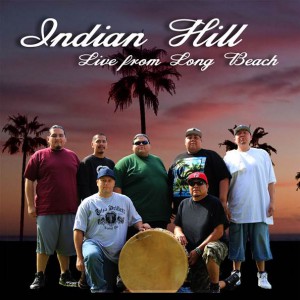
Indian Hill releases new cd, Indian Hill : Live from Long Beach
Recorded live at the CSULB 46th Annual Pow Wow at Puvungna in March of 2016. The album consists of fourteen songs recorded when Indian Hill was our host Northern Drum. You can purchase a physical cd copy from Blood River Entertainment (or from any of the singers). Link to purchase CD
Digital Downloads can be purchased at the following links.
iTunes link Amazon link Google Music link Cdbaby link
California Indian Artist Gail Werner
Not to be confused with the Annual CSULB Pow Wow at Puvungna, the Hawaii based arts organization POW! WOW! Hawaii will return to Long Beach with the second year of the POW! WOW! Long Beach arts event. Link to POW! WOW! Long Beach
This 2016 season when POW! WOW! Long Beach returns, will include a mural by our own CSULB Alumna, Gail Werner (Cupeño, Luiseño, and Kumeyaay). The mural production will be lead by CSULB Alumnus, Ian Salt (AIS Minor and Art Major), assisted by AIS Minors, Art Majors and American Indian Student Council members. Link to Gail Werner’s Webpage
Spring 2016 Puvu Lecture Series
The Puvu Indigenous Cultural Sustainability Series returns for the second semester this April.
![CULTURAL [SUSTAIN]-spring2016](https://cla.csulb.edu/departments/americanindianstudies/wp-content/uploads/2015/06/CULTURAL-SUSTAIN-spring2016-300x225.jpg) Location: Cal State Puvungna (CSULB), LA5-355
Location: Cal State Puvungna (CSULB), LA5-355
‘Ekweenax Tovaangara” (Taking Care of the Mother Earth) the Puvu Indigenous Cultural Sustainability Lecture Series is a Lecture Series that collaboratively brings together a series of speakers addressing the impacts of global warming and potential solutions for creating culturally and environmentally spaces for future generations. Speakers range from local Native Americans (Tongva/Gabrielino), a Purepecha community member, to City of Long Beach officials and CSULB administrators. Students will learn about the history of land (Puvungna) and “The People,” the original biodiversity of lands and oceans in Los Angeles and northern Orange Counties, the City of the Long Beach, Native American Food Sustainability Practices, and local responses, conflict-resolutions and problem-solving methods, for creating a sustainable future.
Biographies
Larry Rich, Environmental Coordinator of the City of Long Beach and CSULB alumni will provide an in-depth historical narrative on the topographical changes in the City of Long Beach and articulate the City’s struggles and successes for implementing sustainability programs.
Cindi Alvitre (Tongva/Gabrielino), lecturer for the American Indian Studies Program and Anthropology Department, will provide an enriching narrative on the Indigenous peoples of Los Angeles and northern Orange Counties by articulating the cultural significance of Puvungna (CSULB) and discuss the lack of culturally, environmental sustainable spaces.
Abe Sanchez (Purepecha), Promoter in the Revitalization of Indigenous Arts and Foods, will demonstrate the utilization of traditional plants from the region for culturally and sustainable purposes.
David Salazar, Associate Vice President of Physical Planning and Facilities Management at CSULB, will articulate CSULB sustainability practices and policies.
Craig Torres (Tongva/Gabrielino), Ti’at Society member and cultural revitalist, will discuss the original topographical and maritime flora and fauna biodiversity of the Tongva/Gabrielino.
Inquiries about the series should be directed to Larry.Smith@csulb.edu
Fall Lecture Series:
Congratulations to the CSULB Sustainability Community on an excellent Series coordinated by AIS faculty working in partnership with the American Indian Studies Program and the Film and Electronic Arts Department. Larry Smith is also overseeing the production of short films to document this lecture series.
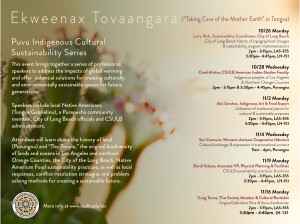 “‘Ekweenax Tovaangara” (Taking Care of the Mother Earth): the Puvu Indigenous Cultural Sustainability Series
“‘Ekweenax Tovaangara” (Taking Care of the Mother Earth): the Puvu Indigenous Cultural Sustainability Series
Locations: Cal State Puvungna (CSULB), LA5-355, and LH-151
‘Ekweenax Tovaangara” (Taking Care of the Mother Earth) the Puvu Indigenous Cultural Sustainability Lecture Series is a Lecture Series that collaboratively brings together a series of speakers addressing the impacts of global warming and potential solutions for creating culturally and environmentally spaces for future generations. Speakers range from local Native Americans (Tongva/Gabrielino), a Purepecha community member, to City of Long Beach officials and CSULB administrators. Students will learn about the history of land (Puvungna) and “The People,” the original biodiversity of lands and oceans in Los Angeles and northern Orange Counties, the City of the Long Beach, Native American Food Sustainability Practices, and local responses, conflict-resolutions and problem-solving methods, for creating a sustainable future.
Biographies, Dates, Times, and Locations
Week 1
- Larry Rich, Environmental Coordinator of the City of Long Beach and CSULB alumni will provide an in-depth historical narrative on the topographical changes in the City of Long Beach and articulate the City’s struggles and successes for implementing sustainability programs.
Date and Locations: 10/26/2015, Monday, 2pm to 3:15pm, Location: LA5-355 — 3:30pm to 4:45pm, Location: LH-151.
- Cindi Alvitre (Tongva/Gabrielino), lecturer for the American Indian Studies Program and Anthropology Department, will provide an enriching narrative on the Indigenous peoples of Los Angeles and northern Orange Counties by articulating the cultural significance of Puvungna (CSULB) and discuss the lack of culturally, environmental sustainable spaces. Date: 10/28/2015, Wednesday, 2pm to 3:15pm and 3:30pm to 4:45pm at Puvungna (near Lot 20 and the Japanese Gardens).
Week 2
Abe Sanchez (Purepecha), Promoter in the Revitalization of Indigenous Arts and Foods, will demonstrate the utilization of traditional plants from the region for culturally and sustainable purposes.
Date and Locations: 11/02/2015, Monday, 2pm to 3:15pm, Location: LA5-355 — 3:30pm to 4:45pm, Location: LH-151
Seri Comca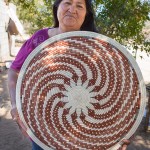 ‘ac Women’s Artisans Cooperative (from Mexico) at Puvungna will provide cultural exchange and expressions. Discussion regarding the reflective problematics of cultural sustainability within a transnational context will occur.
‘ac Women’s Artisans Cooperative (from Mexico) at Puvungna will provide cultural exchange and expressions. Discussion regarding the reflective problematics of cultural sustainability within a transnational context will occur.
Date and Location: 11/04/2015, Wednesday from 1pm to 4pm at Puvungna (near Lot 20 and the Japanese Gardens).
Week 3
David Salazar, Associate Vice President of Physical Planning and Facilities Management at CSULB, will articulate CSULB sustainability practices and policies.
Date and Locations: 11/09/2015, Monday, 2pm to 3:15pm, Location: LA5-355 — 3:30pm to 4:45pm, Location: LH-151
Week 4
Craig Torres (Tongva/Gabrielino), Ti’at Society member and cultural revitalist, will discuss the original topographical and maritime flora and fauna biodiversity of the Tongva/Gabrielino.
Date and Locations: 11/16/15, Monday, 2pm to 3:15pm, Location: LA5-355 — 3:30pm to 4:45pm, Location: LH-151
Need Your Help Fundraising for Perpetual Scholarship for American Indian Students
Need Your Help Fundraising for Perpetual Scholarship for American Indian Students
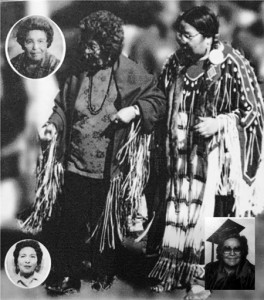 We are nine-thousand dollars shy of our goal to make the Charlotte Standing Buffalo Memorial Scholarship Fund a perpetual scholarship. We have been given a three-month deadline to raise this money and to realize our vision to establish an endowment to support our American Indian students at CSULB. Please help us meet this goal by donating any amount you can to this fund and tell your friends and relatives to support this by clicking on this. Link to Give.
We are nine-thousand dollars shy of our goal to make the Charlotte Standing Buffalo Memorial Scholarship Fund a perpetual scholarship. We have been given a three-month deadline to raise this money and to realize our vision to establish an endowment to support our American Indian students at CSULB. Please help us meet this goal by donating any amount you can to this fund and tell your friends and relatives to support this by clicking on this. Link to Give.




